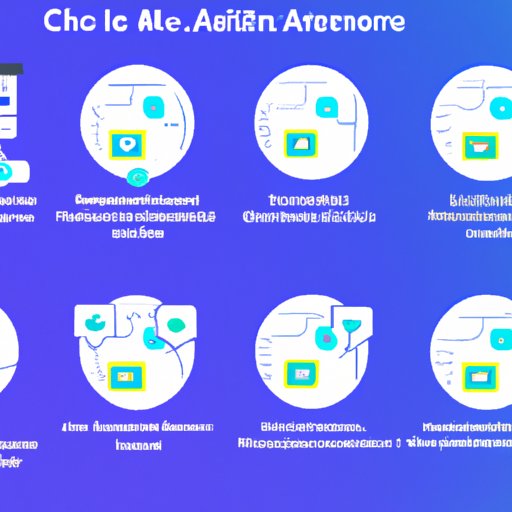Introduction
An artificial intelligence (AI) chatbot is a computer program that is programmed to simulate a conversation with human users. It is used as a tool to provide customers with automated customer service, information, and support. Chatbots are becoming increasingly popular due to their ability to quickly and accurately respond to user queries, making them an invaluable asset in customer service.
The benefits of using an AI chatbot include improved customer satisfaction, cost savings, and increased efficiency. AI chatbots can also be used to improve customer engagement by providing personalized content and recommendations based on user preferences. This makes them ideal for businesses looking to provide a better customer experience.

Components of Building an AI Chatbot
Building an AI chatbot involves four key components: defining a clear purpose for the chatbot, designing and developing it, choosing an AI chatbot framework or platform, and testing and deploying it. The following sections will discuss these components in more detail.
Defining a Clear Purpose for the Chatbot
The first step in building an AI chatbot is to define a clear purpose for the chatbot. This includes identifying the types of tasks the chatbot should be able to perform, such as answering customer inquiries or providing product recommendations. It is important to clearly define the purpose of the chatbot as this will determine the type of technology and features required for its development.
Designing and Developing an AI Chatbot
Once the purpose of the chatbot has been established, the next step is to design and develop the chatbot. This involves selecting the right technologies and tools, such as natural language processing (NLP) and machine learning (ML), to enable the chatbot to understand user queries and respond appropriately. Additionally, the user interface of the chatbot needs to be designed to ensure an intuitive and user-friendly experience.
Choosing an AI Chatbot Framework or Platform
Once the chatbot has been designed and developed, the next step is to choose an AI chatbot framework or platform. This will provide the necessary infrastructure and tools for the chatbot to function properly. Popular frameworks and platforms include Amazon Lex, Dialogflow, Microsoft Bot Framework, and IBM Watson.
Challenges with Maintaining an AI Chatbot
Maintaining an AI chatbot can be challenging. There are three main challenges associated with maintaining an AI chatbot: keeping the chatbot relevant, upgrading and optimizing the chatbot, and ensuring security and privacy.
Keeping the Chatbot Relevant
A chatbot needs to be kept up to date with the latest trends and changes in order to remain relevant. This involves regularly monitoring user feedback and adjusting the chatbot accordingly. Additionally, new features and updates may need to be added over time in order to keep the chatbot functioning optimally.
Upgrading and Optimizing the Chatbot
In order to ensure the best possible user experience, it is important to regularly upgrade and optimize the chatbot. This includes updating the chatbot’s algorithms and technologies, as well as adding new features to improve its performance. Additionally, the chatbot’s user interface should be optimized to ensure a seamless experience for users.
Ensuring Security and Privacy
It is important to ensure that the chatbot is secure and respects user privacy. This involves implementing appropriate security measures such as data encryption and authentication. Additionally, the chatbot should be configured to comply with relevant privacy regulations such as the EU’s GDPR.

Examples of Successful AI Chatbots
There are many examples of successful AI chatbots. Some of the most notable examples include Microsoft’s Xiaoice, Amazon’s Alexa, and Google’s Duplex.
Microsoft’s Xiaoice
Xiaoice is a popular AI chatbot developed by Microsoft. It is capable of understanding and responding to user queries in natural language. Xiaoice has been widely adopted in China, where it is used for customer service and entertainment purposes.
Amazon’s Alexa
Alexa is an AI chatbot developed by Amazon. It is used to provide voice-based services such as playing music, setting alarms, and providing weather forecasts. Alexa is available on a wide range of devices and is widely used by consumers.
Google’s Duplex
Duplex is a conversational AI chatbot developed by Google. It is capable of understanding natural language and carrying out conversations with humans. Duplex is currently being used for booking appointments and making restaurant reservations.
Conclusion
AI chatbots are becoming increasingly popular due to their ability to quickly and accurately respond to user queries. Building an AI chatbot involves defining a clear purpose for the chatbot, designing and developing it, choosing an AI chatbot framework or platform, and testing and deploying it. Additionally, there are challenges associated with maintaining an AI chatbot, such as keeping the chatbot relevant, upgrading and optimizing it, and ensuring security and privacy. Examples of successful AI chatbots include Microsoft’s Xiaoice, Amazon’s Alexa, and Google’s Duplex.
Overall, AI chatbots offer numerous benefits to businesses and organizations, including improved customer satisfaction, cost savings, and increased efficiency. For those considering building an AI chatbot, it is important to consider the components of building an AI chatbot, the challenges associated with maintaining one, and examples of successful AI chatbots. By doing so, businesses and organizations can create a successful AI chatbot that provides an optimal user experience and meets their customer service needs.
(Note: Is this article not meeting your expectations? Do you have knowledge or insights to share? Unlock new opportunities and expand your reach by joining our authors team. Click Registration to join us and share your expertise with our readers.)
